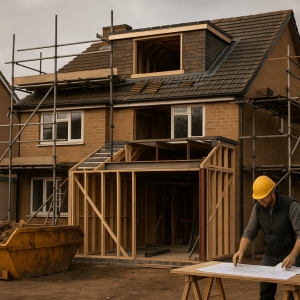Embark on a journey through the world of building materials, from traditional options like wood and concrete to innovative composites, and learn how to select materials that align with your construction goals, budget, and sustainability aspirations.
Understanding Building Materials
Building materials are the foundation of any construction project, influencing not just the structure’s durability and aesthetic but also its long-term sustainability. They range from traditional materials like wood and stone to cutting-edge composites and recycled options.
Key Factors in Choosing Building Materials
1. Functionality
Will the material endure the conditions of its environment? For instance, timber may not suit high-moisture areas without proper treatment.
2. Aesthetic Appeal
Does the material align with your desired architectural style? Stone cladding, for example, adds rustic charm, while glass conveys modernity.
3. Sustainability
With increasing demand for green construction, choosing materials like bamboo or recycled steel can lower your project’s environmental footprint.
4. Budget
Consider both initial costs and long-term expenses, such as maintenance and replacements. Timber might have a higher upfront cost but offers durability that pays off over time.
Types of Building Materials
1. Natural Materials
- Wood: Versatile and aesthetically pleasing, suitable for framing, flooring, and decorative purposes.
- Stone: Durable and weather-resistant, often used for cladding and landscaping.
- Clay: A traditional material with excellent insulation properties, commonly seen in bricks.
2. Synthetic Materials
- Concrete: Strong and versatile, ideal for foundations and structural elements.
- Metals: Steel and aluminum offer unmatched strength for framing and roofing.
- Plastics: Lightweight and cost-effective, frequently used for piping and insulation.
3. Composite Materials
- Fiberglass: Combines flexibility and corrosion resistance, often used in insulation.
- Engineered Wood: Offers the warmth of wood with enhanced strength and stability.
Eco-Friendly and Sustainable Options
Sustainability in construction is no longer optional. Builders are increasingly turning to materials like:
- Recycled Steel: Reduces waste and lowers energy consumption in manufacturing.
- Bamboo: A renewable resource with high tensile strength.
- Precast Concrete Panels: Minimises waste and enhances energy efficiency.
- Green Roof Systems: Incorporate vegetation to improve insulation and air quality.
Cost Considerations
Choosing the right material often comes down to balancing quality with budget. Follow these steps:
1. Research and Compare
Compare materials based on durability, maintenance, and initial costs. Use online calculators to estimate expenses accurately.
2. Consider Lifespan
Invest in materials with longer lifespans, like copper piping or hardwood floors, to save on future repairs or replacements.
3. Use Tools Like Markup Calculators
Markup calculators help you set fair pricing for materials while ensuring profitability.
Expert Tips for Material Selection
- Work with Local Suppliers: Using locally sourced materials can lower costs and reduce environmental impact.
- Consult Professionals: Architects and estimators can offer tailored advice on material compatibility and cost management.
- Plan for Climate: Materials like clay tiles or metal roofs may perform better in certain weather conditions.
Frequently Asked Questions
- What are the most sustainable building materials?
Some of the most sustainable building materials include:
- Bamboo: A rapidly renewable material with excellent strength and flexibility.
- Recycled Steel: Reduces energy consumption and waste while maintaining structural durability.
- Precast Concrete Panels: Produced with minimal waste, offering great insulation and energy efficiency.
- Reclaimed Wood: Salvaged timber that gives a second life to materials, reducing deforestation.
Using sustainable materials helps lower the environmental impact of your construction project while meeting modern green building standards.
- How do wood and steel compare for framing?
Both materials have distinct advantages:
- Wood: Lightweight, cost-effective, and offers natural insulation. However, it’s susceptible to moisture and pests without proper treatment.
- Steel: Extremely strong, fire-resistant, and ideal for larger or more complex structures. It’s more expensive and requires skilled labor for installation.
Your choice will depend on the project’s scale, budget, and environmental conditions.
- Are recycled materials as effective as new ones?
Yes, many recycled materials are as effective as new ones. Recycled steel, for example, is just as strong as newly manufactured steel. Reclaimed wood, when properly treated, offers excellent durability and aesthetics. Using recycled materials not only reduces waste but also contributes to sustainable building practices.
- What factors determine the cost-effectiveness of building materials?
Cost-effectiveness is influenced by several factors:
- Initial Purchase Cost: The upfront price of the material.
- Durability: Long-lasting materials may cost more initially but save money in the long run by reducing replacements.
- Maintenance Requirements: Low-maintenance options, like metal roofing, can be more economical over time.
- Energy Efficiency: Materials that improve insulation, such as precast concrete or fiberglass, can reduce utility costs.
Balancing these factors helps you choose materials that fit your budget while maximizing value.
- Why is it important to consider the local climate when selecting materials?
The local climate significantly impacts the performance and longevity of building materials. For example:
- Hot Climates: Materials like clay tiles or concrete resist heat and are ideal for high-temperature areas.
- Humid Climates: Treated wood or composites that resist moisture are essential to prevent rot and warping.
- Cold Climates: Insulated materials, such as engineered wood or fiberglass, help maintain indoor warmth.
Considering climate conditions ensures that your building materials can withstand environmental stresses, reducing maintenance costs and increasing durability.
- What are common mistakes when choosing building materials?
Some common mistakes include:
- Ignoring Climate Conditions: Choosing materials unsuitable for the environment can lead to premature wear.
- Prioritizing Aesthetics Over Functionality: Beautiful materials that lack durability may result in higher long-term costs.
- Overlooking Maintenance Needs: Neglecting to consider upkeep can lead to unforeseen expenses.
- Not Budgeting for Quality: Opting for cheaper, lower-quality materials may compromise structural integrity.
Avoiding these mistakes ensures a smoother construction process and a longer-lasting structure.
- How can consulting with an estimator help in material selection?
Consulting with an estimator provides several advantages:
- They can offer accurate cost projections for different materials.
- Estimators help identify materials that fit your budget while meeting project requirements.
- They provide insights into long-term costs, such as maintenance and replacement.
Working with an estimator ensures financial clarity and reduces the risk of unexpected expenses during construction.
- Are there specific materials better suited for residential vs. commercial projects?
Yes, the intended use of the structure often dictates material choice:
- Residential: Materials like wood, clay bricks, and engineered wood are commonly used due to their aesthetics and insulation properties.
- Commercial: Steel, concrete, and reinforced composites are preferred for their strength, scalability, and fire resistance.
Understanding the unique demands of each type of project helps in selecting the most appropriate materials.
- What are the benefits of using local materials?
Local materials offer several advantages:
- Reduced Costs: Lower transportation expenses reduce the overall price.
- Sustainability: Local sourcing reduces the carbon footprint of your project.
- Better Suitability: Locally sourced materials are often better suited to the region’s climate and environmental conditions.
Additionally, supporting local suppliers contributes to the community’s economy.
- How can I ensure my material choices are sustainable?
To prioritize sustainability:
- Look for certifications like FSC (Forest Stewardship Council) for wood products.
- Choose recycled or upcycled materials wherever possible.
- Opt for materials with low embodied energy, such as bamboo or natural stone.
- Use durable materials that reduce the need for frequent replacements.
Sustainable choices benefit both the environment and your project’s long-term costs.
- What role does technology play in material selection?
Technology has revolutionized material selection by offering:
- Material Simulations: Software tools simulate how materials perform under different conditions, aiding informed decisions.
- 3D Printing: Enables the creation of custom materials and components on-site, reducing waste.
- Online Tools: Calculators and comparison tools help estimate costs and sustainability metrics.
Embracing technology ensures efficiency and precision in material selection and project planning.











